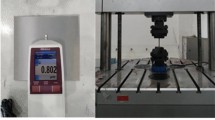Abstract
Tower cranes are used to handle heavy weights, and are typically operated at considerable heights; their slewing reducer has to support both the variable wind loads at those heights and the load resulting from inertia of the system. The analysis of such transmitted loads is extremely important in crane design, to estimate the life expectancy of the slewing reducers. If the input load was measured, the load applied to the carrier of the slewing reducer could be analyzed, its weak parts determined, and the cumulative damage rate calculated; the expected life of the carrier could then be predicted more accurately. Therefore, this study estimated the fatigue life of the reducer’s carrier, using the input load measured during normal operating conditions of the tower crane. The analysis model of the slewing reducer was verified with a static load test, and the stress profile applied to the carrier was calculated using the peak-valley load extracted from the measured input; the verified slewing reducer analysis model, the rain-flow counting method, and Miner’s rule were then used to estimate the expected life of the carrier. As a result, the rates of cumulative damage of the two weakest spots were estimated to be 22.63% and 44.95%.
Similar content being viewed by others
Abbreviations
- Ug :
-
Maximum interference fit
- DP, max :
-
Pin maximum dimensions
- DC, min :
-
Carrier minimum dimensions
- Uk :
-
Minimum interference fit
- DP, min :
-
Pin minimum dimensions
- DC, max :
-
Carrier maximum dimensions
- U:
-
Maximum or minimum interference fit
- Uw :
-
Interference fit considering surface roughness
- RzA :
-
Averaged roughness depth of carrier pin-hole
- RzI :
-
Averaged roughness depth of pin
- SF:
-
Safety factor
- YS:
-
Yield strength of material
- ST:
-
Calculated von-Mises stress
- Seq :
-
Equivalent stress amplitude
- Sa :
-
Stress amplitude
- Sm :
-
Mean stress
- Su :
-
Tensile stress
- Ni :
-
Target life
- Nf :
-
Life with respect to S-N curve
References
Cho, S.-J., Han, J.-W., Park, Y.-J., and Lee, G.-H., “Structural Analysis of a Planetary Gear Carrier in the Slewing Reducer for Tower Crane,” Journal of the Korean Society of Manufacturing Process Engineers, Vol. 13, No. 5, pp. 1–7, 2014. (in Korean)
Cho, S.-J., Park, Y.-J., Han, J.-W., and Lee, G.-H., “Fatigue Life Prediction of the Carrier of Slewing Reducer for Tower Crane,” Journal of the Korean Society of Manufacturing Process Engineers, Vol. 14, No. 3, pp. 131–140, 2015. (in Korean)
Patel, M. M., Joshi, M. N. B., Patel, M. M., and Joshi, N. B., “Design and Fatigue Analysis of Epicyclic Gearbox Carrier,” International Journal for Innovative Research in Science & Technology, Vol. 1, No. 12, pp. 329–333.
Heege, A., Betran, J., and Radovcic, Y., “Fatigue Load Computation of Wind Turbine Gearboxes by Coupled Finite Element, Multi-Body System and Aerodynamic Analysis,” Wind Energy, Vol. 10, No. 5, pp. 395–413, 2007.
Hao, D. and Wang, D., “Finite-Element Modeling of the Failure of Interference-Fit Planet Carrier and Shaft Assembly,” Engineering Failure Analysis, Vol. 33, pp. 184–196, 2013.
Nigam, A. and Jain, S., “Modelling and Structural Analysis of Planetary Geared Winch,” International Journal of Science and Research, Vol. 4, No. 1, pp. 330–333, 2015.
Xing, Y. and Moan, T., “Multi-Body Modelling and Analysis of a Planet Carrier in a Wind Turbine Gearbox,” Wind Energy, Vol. 16, No. 7, pp. 1067–1089, 2013.
Korean Agency for Technology and Standards, “System of Limits and Fits,” KS B 0401, 2014.
Deutsches Institüt fur Normung, “Interference Fits-Calculation and Design Rules,” DIN 7190, 2001.
Wind Energy Committee and Germanischer Lloyd, “Guideline for the Certification of Wind Turbines,” 2010.
Romax Technology Ltd., “RomaxDesigner Software Manual,” 2003.
ANSYS, Inc., “Workbench User's Guide,” 2013.
Author information
Authors and Affiliations
Corresponding author
Rights and permissions
About this article
Cite this article
Park, YJ., Cho, SJ., Han, JW. et al. Fatigue life prediction of planet carrier in slewing reducer for tower crane based on model validation and field test. Int. J. Precis. Eng. Manuf. 18, 435–444 (2017). https://doi.org/10.1007/s12541-017-0052-1
Received:
Revised:
Accepted:
Published:
Issue Date:
DOI: https://doi.org/10.1007/s12541-017-0052-1




